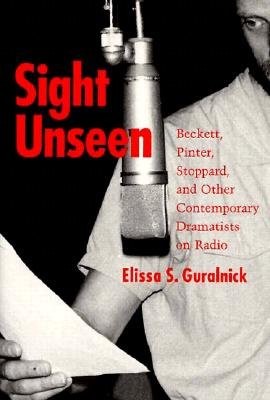
- We will send in 10–14 business days.
- Author: Elissa S Guralnick
- Publisher: Ohio University Press
- ISBN-10: 0821411284
- ISBN-13: 9780821411285
- Format: 15.9 x 23.6 x 2.3 cm, hardcover
- Language: English
- SAVE -10% with code: EXTRA
Reviews
Description
In Sight Unseen radio drama, a genre traditionally dismissed as popular culture, is celebrated as high art. The radio plays discussed here range from the conventional (John Arden's Pearl) to the docudramatic (David Rudkin's Cries from Casement), from the curtly conversational (Harold Pinter's A Slight Ache) to the virtually operatic (Robert Ferguson's Transfigured Night), testifying to radio drama's variety and literary stature. Two of the plays included in this study pose aesthetic questions-the role of art in politics (Howard Barker's Scenes from an Execution), and the nature of artistic excellence (Tom Stoppard's Artist Descending a Staircase).
Guralnick contends that well-crafted radio plays tend to meld to their medium so naturally that they cannot be transferred to the theater or to film without being diminished. Each play is thus shown to exploit, to special effect, one of radio's fundamental features: its invisible stage (Barker and Stoppard), its affinity to music (Ferguson and Beckett), its ability to imitate the mind's subjectivity (Kopit and Pinter), its association with world events through features and the news (Rudkin). As for the question of radio's relation to the theater, the issue is engaged in the work of John Arden, who dares to portray a theatrical stage on the airwaves, while intimating that the radio offers contemporary playwrights an incomparable boon: creative conditions roughly equivalent to those enjoyed by Shakespeare.EXTRA 10 % discount with code: EXTRA
The promotion ends in 20d.08:42:38
The discount code is valid when purchasing from 10 €. Discounts do not stack.
- Author: Elissa S Guralnick
- Publisher: Ohio University Press
- ISBN-10: 0821411284
- ISBN-13: 9780821411285
- Format: 15.9 x 23.6 x 2.3 cm, hardcover
- Language: English English
In Sight Unseen radio drama, a genre traditionally dismissed as popular culture, is celebrated as high art. The radio plays discussed here range from the conventional (John Arden's Pearl) to the docudramatic (David Rudkin's Cries from Casement), from the curtly conversational (Harold Pinter's A Slight Ache) to the virtually operatic (Robert Ferguson's Transfigured Night), testifying to radio drama's variety and literary stature. Two of the plays included in this study pose aesthetic questions-the role of art in politics (Howard Barker's Scenes from an Execution), and the nature of artistic excellence (Tom Stoppard's Artist Descending a Staircase).
Guralnick contends that well-crafted radio plays tend to meld to their medium so naturally that they cannot be transferred to the theater or to film without being diminished. Each play is thus shown to exploit, to special effect, one of radio's fundamental features: its invisible stage (Barker and Stoppard), its affinity to music (Ferguson and Beckett), its ability to imitate the mind's subjectivity (Kopit and Pinter), its association with world events through features and the news (Rudkin). As for the question of radio's relation to the theater, the issue is engaged in the work of John Arden, who dares to portray a theatrical stage on the airwaves, while intimating that the radio offers contemporary playwrights an incomparable boon: creative conditions roughly equivalent to those enjoyed by Shakespeare.

Reviews